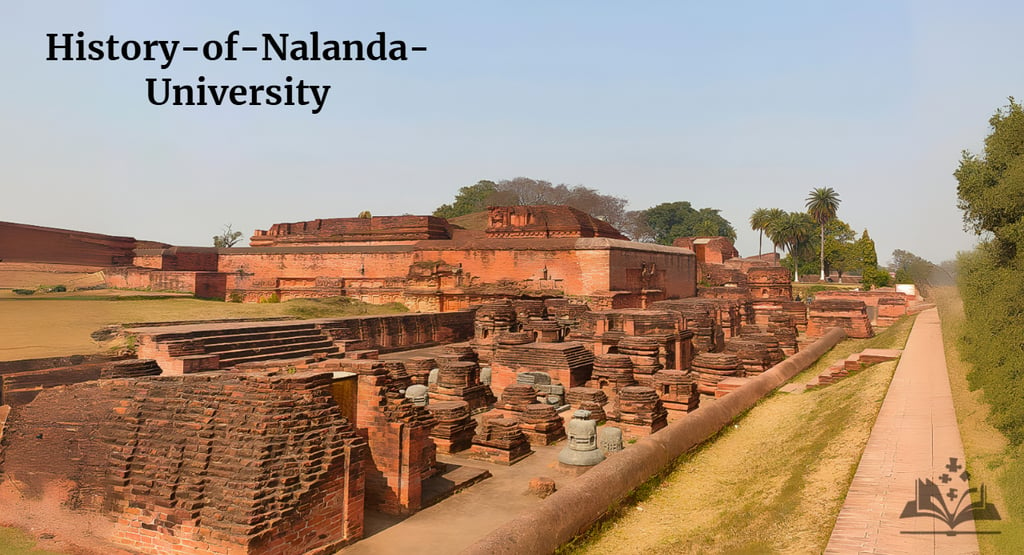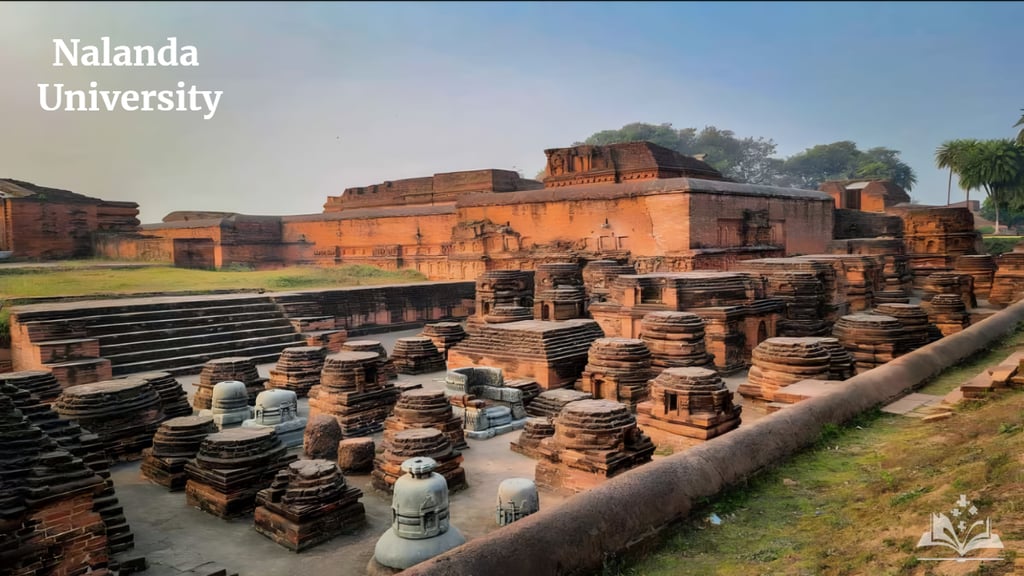
Nalanda University: The Rise, Glory, and Fall of a Global Knowledge Hub?!
Unveiling the Mysteries of Nalanda University: A Deep Dive into the World's First Residential University, its Golden Era, Untold Stories, and Tragic Decline.
INDIAN HISTORYHARSH REALITYBIOGRAPHY/HISTORYINDIA/BHARAT
Sachin K Chaurasiya
12/4/20247 min read


Nalanda University (नालंदा विश्वविद्यालय), located in present-day Bihar, India, was not just an educational institution but a symbol of intellectual brilliance and cultural harmony. Established in the 5th century CE (5वीं शताब्दी ई.) under the patronage of the Gupta Empire (गुप्त साम्राज्य), it flourished as one of the first residential universities in the world, attracting scholars and students from across Asia and beyond. Despite its fame, Nalanda’s ultimate fate was sealed in tragedy, marking one of the darkest chapters in history.
This article uncovers the history, hidden stories, and lesser-known aspects of Nalanda's rise, fall, and enduring legacy.
The Foundation and Growth of Nalanda?!
Nalanda (नालंदा) was founded by Kumaragupta I (reigned 415–455 CE) and expanded over centuries by rulers like Harsha (हर्ष) of the 7th century and the Pala dynasty (पाल वंश) (8th–12th centuries). It became a center of learning, particularly for Buddhist studies, although it also taught subjects like medicine, mathematics, astronomy, architecture, logic, and literature.
Key Features of Nalanda’s Golden Era!
International Influence
Nalanda attracted students from countries like China, Korea, Tibet, Japan, Mongolia, Indonesia, and Persia.
Notable scholars include
Xuanzang (Hsuan-tsang): The Chinese monk spent 15 years at Nalanda and wrote extensively about its curriculum, discipline, and grandeur.
Yijing: Another Chinese pilgrim who praised Nalanda’s scholarly rigor.
Nalanda’s reputation as a hub for Buddhist teachings influenced the spread of Mahayana and Vajrayana Buddhism across Asia.
Vast Campus
Nalanda housed 10,000 students and 2,000 teachers at its peak.
Its multi-story libraries, lecture halls, monasteries, and temples were organized meticulously.
The university’s architecture emphasized sustainability, with well-planned water reservoirs, gardens, and meditation spaces.
Academic Excellence
Admission to Nalanda was highly competitive. Scholars were admitted after passing rigorous oral examinations conducted by gatekeepers.
It offered a structured curriculum, blending religious and secular studies, which influenced later institutions in Asia, such as Tibetan monasteries.
The Library of Nalanda: A Mountain of Knowledge?
The Dharma Gunj (धर्मगंज) (Mountain of Truth) was the heart of Nalanda, consisting of three buildings—Ratnasagara (रत्नसागर), Ratnadadhi (रत्नदधि), and Ratnaranjaka (रत्नरंजका). Each section specialized in different fields, housing millions of manuscripts on Buddhist philosophy (बौद्ध दर्शन), Vedic texts, science, and even foreign literature.
Hidden Stories of the Library
The Underground Vaults: Some sources suggest that Nalanda’s library extended underground. These vaults reportedly contained manuscripts on advanced sciences, metaphysics, and even technology that were never recovered after the invasion.
Burning for Months: Chroniclers like Minhaj-i-Siraj noted that the invaders set the library on fire, and it burned for months due to the sheer volume of manuscripts.
The Decline and Destruction of Nalanda!
Nalanda’s decline began with the weakening of Buddhist patronage under the Chola Empire (चोल साम्राज्य) and later Hindu dynasties (हिंदू राजवंश). However, its ultimate destruction occurred in the late 12th century during the invasion of Bakhtiyar Khilji (बख्तियार खिलजी का आक्रमण), a general under the Delhi Sultanate.
Khilji’s Attack
Khilji’s campaign in Bihar targeted Nalanda for its association with Buddhism, a religion seen as a threat to Islamic expansion.
According to legend, Khilji, dismissive of intellectual pursuits, mocked the university and burned its library, saying, “If these books agree with our religion, they are superfluous; if they disagree, they are blasphemous.”
Massacre of Monks
Thousands of resident monks and scholars were massacred. Survivors fled to Tibet, Nepal, and Southeast Asia, taking fragments of Nalanda’s teachings with them.
Impact on Buddhism
The destruction of Nalanda was a major blow to Buddhism in India, accelerating its decline and shifting its epicenter to other regions like Tibet, China, and Sri Lanka.


Hidden and Lesser-Known Stories of Nalanda
The Escape of Knowledge
While Nalanda’s physical structure was lost, its intellectual legacy survived through the efforts of fleeing monks. They carried sacred texts and teachings to Tibet, where they became the foundation for Tibetan Buddhism (तिब्बती बौद्ध धर्म). The translation of these texts into Tibetan and Chinese preserved much of Nalanda’s scholarship.
The Tibetan Book of the Dead (तिब्बती मृतकों की पुस्तक), a seminal Buddhist text, is said to have roots in Nalanda’s teachings.
Local Myths and Legends
Underground Libraries: Folklore suggests that some manuscripts from Nalanda were hidden in underground chambers or transported to secret locations before the attack. However, these stories remain unverified.
The Curse of Nalanda: Locals believe that the massacre of monks left the site cursed, and no major educational institution could thrive there for centuries.
Resistance Against the Invaders
Though largely unrecorded, oral traditions suggest that some monks and students resisted Khilji’s forces. Their resistance, however, was ultimately futile against the invaders’ army.
Rediscovery and Modern Revival
19th-Century Rediscovery
Nalanda’s ruins were rediscovered by Sir Alexander Cunningham (सर अलेक्जेंडर कनिंघम) and later explored by Sir John Marshall (सर जॉन मार्शल). Excavations revealed:
Stupas, monasteries, and inscriptions.
Seals bearing the name "Nalanda Mahavihara (नालंदा महाविहार)."
Artifacts showcasing advanced craftsmanship and intellectual pursuits.
Modern Efforts
In 2010, the modern Nalanda University was established near the ancient site, aiming to revive its legacy as a global educational hub.
It offers courses in history, ecology, and sustainability, inspired by Nalanda’s original spirit of interdisciplinary learning.
The Enduring Legacy of Nalanda
Nalanda’s tragic end is a testament to the vulnerability of human achievements. Yet, its legacy continues to inspire scholars, historians, and Buddhists worldwide. Its ruins, designated a UNESCO World Heritage Site, serve as a reminder of the need to protect and preserve centers of learning.
The historical significance of Nalanda University (नालंदा विश्वविद्यालय) extends far beyond its role as an educational institution. Its profound cultural, intellectual, and spiritual contributions make it one of the most remarkable achievements of ancient India.
Lesser-Known Historical Connections!
The Role of the Gupta Dynasty
While Kumaragupta I is credited with founding Nalanda, the Gupta dynasty as a whole played a pivotal role in fostering knowledge and education.
Samudragupta (समुद्रगुप्त), Kumaragupta's predecessor, was also known for his patronage of scholars, laying the cultural groundwork for Nalanda’s establishment.
The Pala Dynasty’s Contribution
The Palas of Bengal (8th–12th century) were great patrons of Nalanda, ensuring its survival and expansion during their reign. They financed the construction of additional monasteries and stupas, further enriching the campus.
Harsha's Patronage
Emperor Harsha (सम्राट हर्ष) (606–647 CE), a devout Buddhist, not only supported Nalanda financially but also invited global scholars to visit the university. His role as a cultural ambassador helped establish Nalanda's international reputation.

Cultural and Intellectual Innovations
Mathematics and Astronomy
The Aryabhata School of Mathematics was closely associated with Nalanda, where topics like trigonometry, algebra, and the concept of zero were taught and advanced.
Nalanda scholars were well-versed in Indian astronomy, making contributions to understanding planetary motion, eclipses, and calendars.
Buddhist Medicine and Psychology
Nalanda’s medical teachings were based on Buddhist texts like the Sushruta Samhita (सुश्रुत संहिता) and the Charaka Samhita (चरक संहिता).
The monks studied and practiced healing techniques, blending Ayurveda (आयुर्वेद) with spiritual healing principles.
Nalanda was also an early proponent of mental health studies, focusing on mindfulness, meditation, and ethical living as tools for psychological well-being.
Global Impact on Education
Nalanda’s system of oral examinations and structured teaching methods became a model for other institutions.
Universities like Takshashila in India and later Chang’an and Dunhuang in China borrowed heavily from Nalanda’s curriculum and administrative structure.
More Hidden Stories and Mysteries
The Role of Nalanda in Tibetan Buddhism
Tibetan Buddhism, a major branch of Buddhism today, owes much of its foundation to Nalanda’s scholars, particularly Atiśa Dipankara. He carried Nalanda's knowledge to Tibet, where it became the basis for monastic education.
Tibetan monasteries like Tashilhunpo and Drepung were modeled after Nalanda.
The Mystery of the Lost Texts
Some believe that esoteric Buddhist texts, including those on tantric practices and advanced philosophies, were hidden by fleeing monks during the invasion.
Certain manuscripts are thought to have resurfaced in Tibet and Mongolia, but their authenticity remains debated.
The Merchant Scholars
Historical accounts mention merchants who traveled with students and monks to Nalanda. These traders often carried valuable manuscripts to distant lands, spreading Nalanda's teachings indirectly through trade routes like the Silk Road.
Secret Preservation During the Decline
Oral traditions suggest that during Nalanda’s decline, some monks disguised themselves as local villagers to safeguard their manuscripts and knowledge.
A few of these preserved texts were later used to revive Buddhism in Sri Lanka and Southeast Asia.
Stories of Nalanda's Visitors
Xuanzang’s Journey
Xuanzang’s detailed accounts reveal that Nalanda was more than an academic center; it was a spiritual retreat. He noted the compassionate ethos of its teachers, who welcomed seekers regardless of their religious beliefs.
He carried back over 600 manuscripts, many of which became the foundation for Buddhist studies in China.
Yijing’s Observations
Yijing, another Chinese monk, emphasized the discipline and humility of Nalanda’s scholars. He noted that monks adhered to strict schedules, balancing academic pursuits with meditation and ethical living.
Persian and Arab Scholars
While predominantly a Buddhist institution, Nalanda also hosted scholars from Persia and Arabia, who contributed to the translation of Indian texts into Arabic. These translations influenced Islamic science and philosophy during the Golden Age of Islam.
Archaeological Discoveries and Modern Mysteries
Rediscovery of Artifacts
Excavations have unearthed stone statues, terracotta seals, and metal figurines, showcasing the artistic finesse of Nalanda's artisans.
Inscriptions in Pali (पाली), Sanskrit (संस्कृत), and Prakrit (प्राकृत) have shed light on administrative and cultural aspects of the university.
The Unexplored Ruins
A significant portion of Nalanda remains unexcavated. Archaeologists believe that hidden chambers, underground libraries, and stupas might still be buried beneath the site.
Some unexplored ruins are said to hold manuscripts written on birch bark (भोजपत्र) or palm leaves (ताड़पत्र, ताड़ का पत्ता), which may provide new insights into ancient Indian science and philosophy.
Astronomical Instruments
Fragments of ancient tools used for astronomical observation have been discovered, hinting at Nalanda’s advanced knowledge of celestial phenomena.


Legacy in Modern Context
Nalanda’s Role in Diplomacy
Nalanda was not just a center for education but also a diplomatic hub (कूटनीतिक केंद्र), where intellectual exchanges strengthened ties between India and other Asian countries.
Modern efforts to rebuild Nalanda aims to revive its historical role in fostering international cooperation.
UNESCO World Heritage Site
In 2016, the Ruins of Nalanda Mahavihara (नालंदा महाविहार के खंडहर) were recognized as a UNESCO World Heritage Site, acknowledging their universal value and significance.
Nalanda University (2014)
The re-establishment of Nalanda University underlines its symbolic value as a global knowledge center. It continues to inspire modern education systems, promoting interdisciplinary studies and cultural exchange.
Moral and Philosophical Lessons
The story of Nalanda offers timeless lessons:
Knowledge as a Shared Heritage
Nalanda’s cosmopolitan nature reminds us that education transcends borders, religions, and cultures.
The Fragility of Wisdom
The destruction of Nalanda highlights the need to protect centers of learning from intolerance and violence.
The Resilience of Knowledge
Despite its destruction, Nalanda’s intellectual legacy survived, influencing education systems worldwide.
Sustainable Living
Nalanda’s architectural and environmental innovations serve as early examples of sustainability in design, a lesson relevant even today.
Preservation of Knowledge
Nalanda teaches us the importance of safeguarding intellectual heritage. Its loss is a reminder of how knowledge can fall victim to violence and intolerance.
Resilience of Wisdom
Despite its destruction, Nalanda’s teachings influenced education systems across Asia, and its intellectual spirit lives on in the institutions it inspired.
Nalanda University (नालंदा विश्वविद्यालय) remains an enduring symbol of India's golden age of learning and cultural synthesis. While its destruction was a devastating loss, its story is also one of resilience, innovation, and global influence. By continuing to study its history and legacy, we honor not just Nalanda’s scholars but the universal pursuit of knowledge.
Subscribe To Our Newsletter
All © Copyright reserved by Accessible-Learning Hub
| Terms & Conditions
Knowledge is power. Learn with Us. 📚


